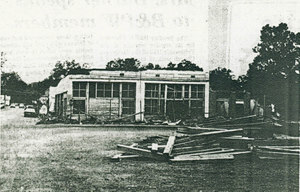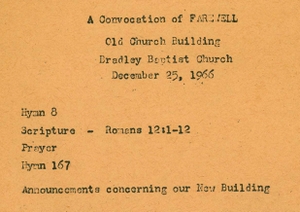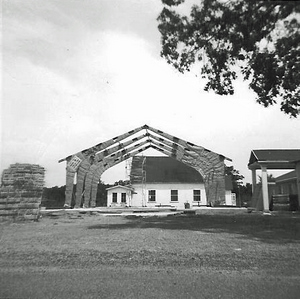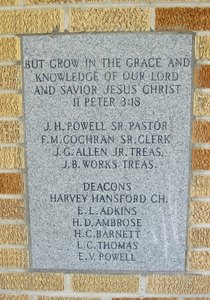The following article, entitled “Big Store No More,” appeared in the Lafayette County Democrat of September 21, 1978, and is reprinted here by permission. It contains a few minor inaccuracies, but is nevertheless an excellent narrative concerning the building it describes and early Bradley history. It was written by John A. “Ardis” Manry, who was a resident of Plain Dealing, but had a keen interest in the history of this entire region. In the later years of his life, his eyesight was quite poor, but it never stopped him from having a cheerful disposition, especially when he could talk about local history. The photo below is quite grainy because is copied directly from the newspaper.

By John A. Manry
The tearing down of three old store buildings, brick by brick, is underway and if bricks could tell everything that had happened there since the beginning of this century, and if the land on which it stands could only tell something of its owners since it was bought from the Government before the Civil War, it might go like this:
The name of the buildings have been changed from time to time, depending [on] who owned them.
Records in the courthouse at Lewisville show that the land was bought from the Government by Alexander T. Evans. Census records kept by the Lafayette County Historical Society show that he and his brother, James K. Evans, both born in Georgia, came here from Alabama with large families, built homes nearby, and both entered the Confederate Army.
Each married daughters of Mr. and Mrs. Elisha Waldrop and were active in the Methodist Church there. It was in the winter of 1867 [when] they were instrumental in arousing the countryside by preaching that converts came pouring in.
It was a part of the “Great Awakening” prevalent over our country at that time, but descendants of these people living at Bradley still refer to the great awakening at nearby Walnut Hill as that “Christmas meeting.”
The records are not too exact why the Bradley land was sold or lost, but possibly it was lost because of educating so many of the Evans family to the ministry. Some say eight of the boys became ministers, mostly Methodist, of course, but there was a sprinkling of Baptist, too.
By 1885 Cassius Leigh owned the land. That year he deeded it to a H. G. Allis, who is believed to have been a land speculator anxious to make a profit. He sold it to the Southwestern Improvement Association just before the Cotton Belt decided to extend their railroad from Lewisville to Shreveport in 1888.
COMING OF RAILROAD
The Southwestern Improvement Assoc. had played an important part in laying out the town of Galveston, where Lewisville is now, and other towns along the Cotton Belt by selling off lots, making a profit and moving on.
It was 10 years later that the Improvement Association sold this part of land to D. D. Hamiter, a son of John H. Hamiter and a grandson of John Hamiter who had moved to the northern part of Bossier Parish in the 1840’s from Houston County, Georgia.
A glance at the valuation of this land showed that it was tripled in value during the year 1900, indicating that some improvements had been made on the property then. Sometime later another brick building was built alongside it.
FIRST TELEPHONE HERE
While D. D. Hamiter operated the store he was acting depot agent. In time his brother Eugene became a partner, and they called their store the Hamiter Brothers Mercantile Company.
Mrs. Aletha Hamiter Barker, now a resident of the Homestead Manor Nursing Home in Stamps, in her “Scrapbook of Roane Township,” writes that “when the telephone system was first organized (1901, in Walnut Hill), there was only one phone in Bradley and it was in Hamiter Bros. store. Anytime, day or night, a person wanted to call a doctor, or on account of a sudden death or accident, some member of the mercantile company had to get up and go open the store and stay until the necessary call was completed. Usually, some of the clerks slept in the store for this purpose,” she said.
BRADLEY BECOMES A VILLAGE
By 1905 the residents of Bradley petitioned the County Court to become a village and the streets were laid off into 21 blocks, starting from present-day Highway 29, which was called Express Street, and all but one street running parallel with it were named after parts of a train. They were Coach Street, Cab Avenue, Pilot Avenue, Pullman Street, and then Woodruff Street, perhaps named for the publisher of the Arkansas Gazette. Cross streets were numbered from First to Seventh from the Methodist Church on the south, to the present-day Baptist church on the north.
This placed the brick store buildings on the corner of Pilot Avenue and Fourth Street, now known as Highway 160 West.
In 1911 J. B. Burton, Sr., bought the property from the Texarkana National Bank and Olin Longino [began] operating a store there known as Burton and Longino. Burton’s heirs sold to B. G. Jester and the Jester heirs sold to Richard D. Smith of Bradley. This year, the building was sold to Lane Pierce, president of the Bank of Bradley.
In the early days the stores all faced the railroad, but the coming of the automobiles cause them to face the highways and such happened to this old store building.
HOUSED POST OFFICE
In 1939 the U. S. Government leased the corner building for a post office. It remained here until their present post office was built.
FIRST BANK BUILDING
The Bank of Bradley was organized in September of 1912, and the third brick building was built. A big barbecue was given and this event attracted crowds of hungry visitors, the Democrat reported.
This building came into the news again when it was robbed by three professional bank robbers escaping with $312, all the money they could find in the open trays on the bank’s counter. The vault, they could not open. It became such a bastion in time that Frank M. Cochran, Jr., bought the old vault door as a reminder of how it had withstood the robbers.
Eventually one of the robbers was sentenced to Alcatraz and is said to have offered to return his part of the loot, but it was never received.
It’s gone today. It will be missed. It was THE big store in its day and old-timers will never forget how majestically it reared its head through its 78 years of service. Peace to its brick dust!












